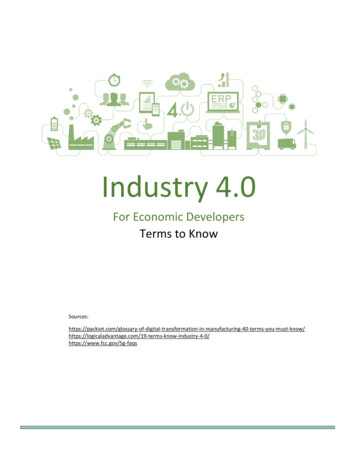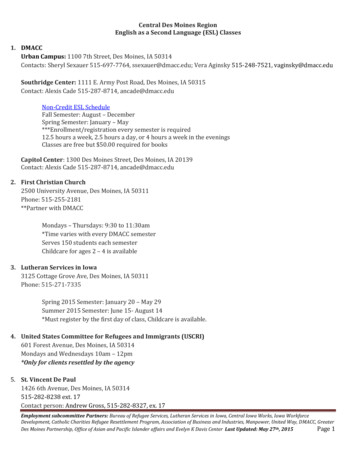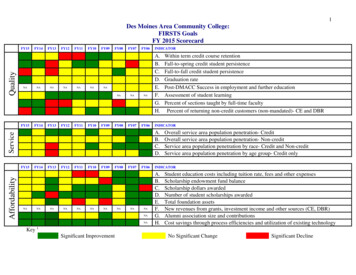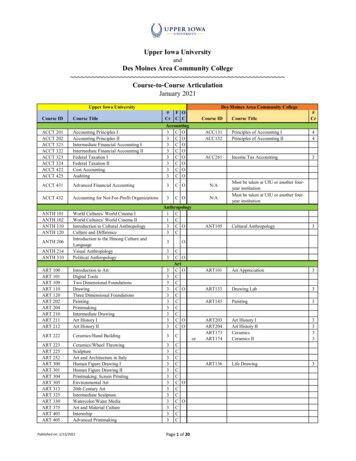
Transcription
Industry 4.0For Economic DevelopersTerms to industry-4-0/https://www.fcc.gov/5g-faqs
3D Simulation: Products, materials or even processes that can be simulated in 3D: so that it is possibleto analyze actual data and thus improve the models before implementation.5G Technology: 5G stands for the fifth generation of mobile communications. 5G technology providesconsumers faster data rates with lower latency, or delays, in transmitting data. It also promises morecapacity for a more efficient network and energy savings. It enhances existing networks and broadenuses like telemedicine and virtual reality.Administration Shell: A popular rising Industry 4.0 term, an administrative shell describes the process ofautomating generic admin tasks. (Related terms: administration system)Advanced Manufacturing: The combination of automation in industry, with advances in computing,connectivity, and IT. Advanced manufacturing enables production to be much faster, more flexible andintegrated. In addition, it can be managed remotely and in real-time.Advanced Robotics: The technology that makes it possible to use robots in industry and services, suchas manufacturing, maintenance, cleaning, and other functions. Their usage in factories creates a moreagile, productive, competitive and safe market. Industrial robots usually perform repetitive tasks thatrequire precision.Algorithm: A sequence of mathematical instructions and rules that a computer uses to calculate ananswer.Artificial Intelligence (AI): Artificial Intelligence enables machines to learn patterns and make decisionsfor themselves. In industry, it allows a large increase in production at a much lower cost, making plantsmore competitive and efficient.Augmented Reality (AR): Augmented reality (AR) is an interactive experience of a real-worldenvironment where the objects that reside in the real world are enhanced by computer-generatedperceptual information, sometimes across multiple sensory modalities, including visual, auditory, haptic,somatosensory and olfactory.Automation: Describes the use of digital systems to control equipment and machinery within a factory.Autonomous: These are technologies that can work on their own, without human intervention. Robots,drones and even cars can be autonomous. They automate functions using artificial intelligence and caninteract with other machines, objects, and people, in an intelligent way.Big Data: It corresponds to the huge volume of data constantly collected, processed and analyzed bysoftware/models. They can be used to predict patterns, detect errors, and understand the consumptionprofile of customers. It is based on this data that the Internet of Things, Artificial Intelligence, DeepLearning, and many other Industry 4.0 technologies work. Get more info on Big Data.Blockchain: A blockchain is a growing list of records, called blocks, which are linked using cryptography.Each block contains a cryptographic hash of the previous block, a timestamp, and transaction data. Bydesign, a blockchain is resistant to data modification. It is “an open, distributed ledger that can recordtransactions between two parties efficiently, and in a verifiable and permanent way”.1
Business Intelligence: Business intelligence is taking data and transforming it into action and extractingfeasible insights from it. It comprises the strategies and technologies used by businesse for the dataanalysis of business information. BI technologies provide historical, current, and predictive views ofbusiness operationsCloud Computing: Cloud computing is the delivery of computing services—including servers, storage,databases, networking, software, analytics, and intelligence—over the Internet (“the cloud”) for fasterinnovation, flexible resources, and economies of scale. In regard to Industry 4.0, cloud computing plays acentral role in where–and how–data is be stored.Cloud Robotics: As mentioned under cloud computing, communication between the physical and digitalworlds will be controlled in the cloud. And with cloud robotics, communication can be more easilymanaged between robots used in mobile applications. (Related term: robofactory)Collaborative Robots: A type of machine that, unlike traditional ones, can work alongside humanswithout any safety risk. They perform numerous functions and are very adaptable, changing activity orworking capacity according to the demand of the moment.Cyber Physical Production Systems: In a cyber-physical system, also known as a CPS, physical and digitalentities are connected, monitored and managed with computer programming and algorithms. (Relatedterm: CPS platform)Cyber-Resilience: This is a “new” term, and only used in specific contexts of modern businesschallenges. At its simplest, being cyber-resilient means taking measures to prevent and protect againstthe criminal or unauthorized use of electronic data.Data Monetization: Refers to how a business is using data for financial benefit. Internal or indirectmethods include using data to make measurable business performance improvements and informdecisions (Risk mitigation and fraud detection, customer targeting, value-add services, product orservice customization, data syndication to customers).Data Science: This is an academic/professional field that comprises several components for data analysisand interpretation through mathematics, statistics and information technology. A data scientist not onlycollects and analyzes inputs, but also interprets and relates the facts to the context in which they areinserted.Deep Learning: Deep learning is part of a broader family of machine learning methods based on artificialneural networks with representation learning. Learning can be supervised, semi-supervised orunsupervised.Digital footprint: Whenever one uses the Internet, or even a cell phone, a digital footprint is the markleft behind. (Related terms: digital shadow, digital risk)Digital Supply Chain: An environment where processes are web-based. To successfully implementIndustry 4.0 concepts, businesses will need to integrate a digital supply chain into their processes.Greater connectivity allows greater sharing of manufacturing processes, production control andscheduling.2
Digital Twin (or digital model): A virtual model of a process, product or service. This pairing of thevirtual and physical worlds allows analysis of data and monitoring of systems to head off problemsbefore they even occur, prevent downtime, develop new opportunities and even plan for the future byusing simulations. A digital twin is associated with an object that actually exists.Edge Computing: Edge computing is where processing takes place at (or near) the physical location ofthe user or data source. With the closest processing, users benefit from faster and more reliableservices, while enterprises take advantage of the flexibility of hybrid cloud computing. Edge computingis one way a company can use and distribute a pool of resources across a large number of locations.Edge Ggateway: An edge gateway serves as a network entry point for devices typically talking to cloudservices. They also often provide network translation between networks that use differentprotocols. (Related term: entry device)ERP: Enterprise Resource Planning and refers to software and systems used to plan and manage all thecore supply chain, manufacturing, services, financial and processes of an organization.Fog Computing: Extending cloud computing to the edge of an enterprise’s network, reducing theamount of data transferred to the cloud for processing and analysis, improving security. This createsefficiencies and has opportunities for companies concerned with compliance issues.Human-Machine-Interface (HMI): HMI is the space where interactions between humans and machinestake place. Applications within Industry 4.0 center around machine control achieving new levels ofsafety and efficiency.Industrial Software: These are programs that help in the collection, manipulation, and evaluation ofdigital data from industry. With industrial software, the connected machines take all the data to a singlesystem.Industry 4.0: Industry 4.0 is the subset of the fourth industrial revolution that concerns the industry. Thefourth industrial revolution encompasses areas that are not normally classified as an industry, such assmart cities, for instance. Although the terms “industry 4.0” and “fourth industrial revolution” are oftenused interchangeably, “industry 4.0” factories have machines which are augmented with wirelessconnectivity and sensors, connected to a system that can visualize the entire production line and makedecisions on its own. In essence, industry 4.0 is the trend towards automation and data exchange inmanufacturing technologies and processes which include cyber-physical systems (CPS), the internet ofthings (IoT), industrial internet of things (IIoT), cloud computing, cognitive computing, and artificialintelligence. According to PwC, the concept of Industry 4.0 should be based on three different pillars:digitalization and integration of vertical and horizontal value chains, digitalization of products andservices, and digital business models and the consequent access of the consumer.Innovation: The provision of better solutions that meet new requirements, or new and existing marketneeds. Innovation takes place through the development of more-effective products, processes, services,technologies, or business models.Internet of Things (loT): A network of web-enabled machines or other connected devices that arecapable of collecting, exchanging, and acting on data in real-time, including sensors, RFID tags, and IPaddresses for the networked interconnection of everyday objects.Interoperability: A computer system or software’s capacity to communicate and exchange data withother machines and software systems.3
Intrapreneur: Self-motivated, proactive, and action-oriented people (employees) who take the initiativeto pursue an innovative product or service.Intrapreneurship: A system and culture that allows an employee to act like an entrepreneur within acompany or other organization. Allows employees to use their entrepreneurial skills for the benefit ofboth the company and the employee.Lights Out Environment: Lights out manufacturing is a methodology, rather than a specific process,referring to fully automated factories that run ‘lights out’ and require no human presence on-site,hence, they can run with the lights off. A fully automatic factory is one where raw materials enter andfinished products leave with little or no human intervention.Machine-to-Machine Communication (M2M): When networked devices can exchange information andperform actions without the manual intervention of humans. The technology that underpins theInternet of Things.Machine Vision System (MVS): A type of technology that is a combination of hardware and softwarethat provides operational guidance (inspect, evaluate and identify) to devices in the execution of theirfunctions based on the capture and processing of images. Used for quality control, defect detection,part selection, etc.Manufacturing Execution System (MES): A production system that allows real-time management. Thesystem records and links operational data (from machines and personal deployment), and is usuallyconnected to the organization’s additional automation systems. MES operates at the operationalmanagement level and creates a link between the corporate and operational management levels.Open Data: Open data is data that is available for public use without restrictions.Open Systems Interconnection (OSI): This is a model that describes how different components in anetwork communicate with each other. OSI divides communication into 7 layers, called stations. Allstations are recorded in a protocol so that they can receive the necessary information from the innerlayer and thus function effectively.Overall Equipment Effectiveness (OEE): The evaluation of how effectively equipment is working in amanufacturing environment.Platform: A system comprising a hardware device together with an operating system that anapplication, program or process can run upon.Predictive Maintenance: The capacity to predict the productivity and maintenance needs of machineswithin a smart factory. Predictive maintenance also has potential is for machine manufacturers to havedata coming back to them after their products are installed in the customer’s factories. By betterunderstanding how a product is used and being able to detect defects (and ideally, remotemaintenance) leads to better future design and improved customer relationships.Process Integration: Digital sharing with outside suppliers and internally (vertical and horizontal).Production Analytics (software): A production analysis software is a platform that helps to visualize realtime the data of machines, lines and factories. In addition to live tracking, it also analyzes historical dataand makes predictions based on inputs collected from sensors.4
Provisioning: This term refers to the process of enrolling, or implementing, a device into a system.RAMI 4.0 (Reference Architecture Model Industry 4.0): RAMI 4.0 is a three-dimensional structuralmodel that presents the levels and participants of Industry 4.0 in a way that is easy to understand. Inthis model, the processes are divided into smaller units and it is possible to visualize the structurehierarchy of a modern plant. The functions, processes and data are integrated, allowing a description ofthe product life cycle. RAMI 4.0 enables the exchange information securely and develop themanufacturing process.Software as a Service (SaaS): SaaS is a form of software distribution and marketing. In the SaaS model,the software supplier is responsible for all the necessary structures to make the system available(servers, connectivity, information security care), and the client uses the software via Internet, paying afee for the service.SCADA (Supervisory Control and Data Acquisition): This is an application rather than a specifictechnology. A control system in which peripheral devices are used to the interface, in addition tocomputers and other networks.Smart Factory: Factories that are monitored by artificially intelligent machines that oversee themanufacturing process, reducing the manpower traditionally required on the factory floor. The dataprovided by the connected elements brings huge opportunities for businesses to better understandtheir process, potential flaws and, ultimately, to implement considerable efficiencies.Smart Manufacturing: Smart manufacturing is used to describe an environment in which computers arein charge of decision-making. In a smart manufacturing environment, physical and digital are connectedand communicate with one another to improve production. (Related terms: smart factory, smartproduction, smart data)Smart Sensor (or IIoT Sensor): A device that collects a specific type of data from a physical environment(outside or inside). It takes that information and uses computing resources that are built into the sensorto perform a programmed function on the data it is collecting. It then passes that data on via anetworked connection.Value-added: One of the most popular words to describe the potential outcomes of Industry 4.0, valueadded refers to the savings these integrated processes are expected to bring. (Related terms: valueadded system, value-added chain, value-added process)Virtual Reality (VR): A computer-generated simulation of a three-dimensional image that can beinteracted with in a seemingly real or physical way by a person using special electronic equipment. Inthe manufacturing environment it can allow for rapid visualization, prototyping and simulation.5
Industry 4.0: Industry 4.0 is the subset of the fourth industrial revolution that concerns the industry. The fourth industrial revolution encompasses areas that are not normally classified as an industry, such as smart cities, for instance. Although the terms "industry 4.0" and "fourth industrial revolution" are often











